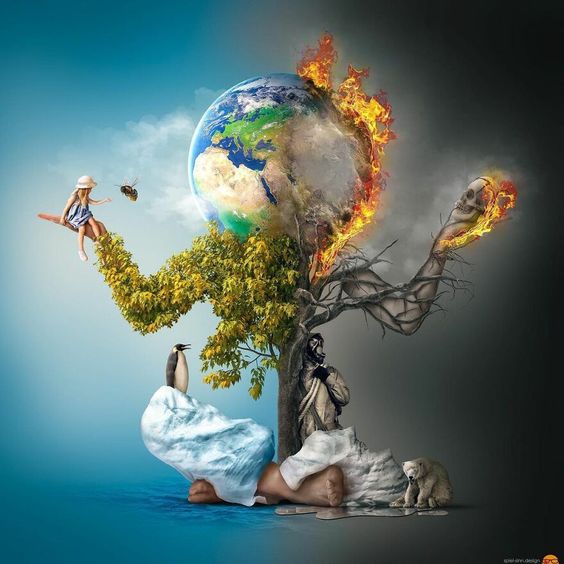The phenomena of rising average air temperatures near the Earth’s surface over the last one to two centuries, which occurs primarily in the troposphere, the lowest level of the atmosphere that expands from the Earth’s surface to an altitude of 6-11 miles.
what is global warming?
One of the most important environmental issues confronting our globe today is global warming. It refers to the long-term rise in the average surface temperature of the Earth caused by human activity, namely the release of greenhouse gases. This phenomenon has far-reaching implications for the climate, ecosystems, and human societies on our planet.
Causes of Global Warming:
- Burning Fossil Fuels: The burning of fossil fuels for energy generation, transportation, and industrial operations is a major source of CO2 emissions. The combustion of coal, oil, and natural gas emits huge amounts of CO2 into the environment.
- Deforestation: Deforestation lowers the Earth’s ability to absorb CO2 through photosynthesis. This not only contributes to rising CO2 levels, but also to habitat loss and diminished biodiversity.

- Industrial Processes: Certain industrial activities, such as refrigerants (CFCs and HFCs) and chemical manufacturing processes (perfluorocarbons), generate potent greenhouse gases that can have a major warming effect.
- Expanding cattle farming: When cows and sheep digest their meal, they produce a lot of methane.
- Fluorinated gases are released by the equipment and products that use them. Such emissions have a much stronger warming effect than CO2, up to 23 000 times stronger.
Effects of Global Warming:
- Rising Temperatures: Global warming raises average global temperatures, resulting in more frequent and severe heatwaves.
- Threats to the Ecosystem: Global warming has harmed coral reefs, perhaps resulting in the extinction of plants and animals. The declining state of coral reefs has been accelerated by rising global temperatures.
- Climate Change: Global warming has resulted to a change in climatic conditions. There are droughts and floods in some areas. The cause of this climatic a conflict is global warming.
- Spread of Diseases: Global warming causes changes in heat and humidity patterns. This has resulted in the spread of mosquitos, which carry and spread diseases.
- High Mortality Rates: As the number of floods, tsunamis, and other natural disasters grows, so does the average death toll. Furthermore, such situations can result in the spread of illnesses that endanger human life.
- Loss of Natural Habitat: A global shift in climate causes the extinction of many flora and animals. In this case, the creatures must leave their natural home, and many of them become extinct. This is yet another significant effect of global warming on biodiversity.
- Melting Ice and Rising Sea Levels: Rising temperatures melt polar ice caps and glaciers, contributing to rising sea levels. This endangers coastal communities and ecosystems.
- Extreme Weather Events: Climate change is associated with more frequent and intense weather events such as hurricanes, droughts, and floods.
- Ocean Acidification: Increased CO2 levels cause ocean acidification, which harms marine life, especially coral reefs and shellfish.
- Extinction of Species: Many plant and animal species are failing to adapt to rapidly changing habitats, putting them at risk of extinction.

Natural Causes of Global Warming:-
- Permafrost Melting
Permafrost can be found anywhere there is tundra or glaciers. For generations, this frozen soil has held environmental gases. Permafrost covers one of the largest areas in Siberia, although it is also accessible in parts of Alaska and Canada. Permafrost is melting and releasing gases back into the atmosphere as a result of global warming.
- Forest Fires
Natural forest blazes, sometimes known as forest fires, represent a threat to the Earth’s atmosphere. While the monetary loss can be compensated for, the environmental consequences constitute a serious threat to the globe. Forest fires release carbon-laden smoke into the atmosphere. These gases become trapped in the atmosphere, making the planet warmer than it was previously.
- volcanic eruptions
Not all of global warming is caused by man-made factors; nature also plays a role. Volcanoes are the natural contributors. When they erupt, a plume of ash and smoke rises into the atmosphere, where it can have a significant impact on the climate. While volcanoes make the list because they can be substantial contributors when they erupt, they don’t erupt frequently enough to compete with cities.
- water vapor
Water vapor is simply water in its gaseous condition. It exists in the atmosphere and has a significant impact on weather and climate. As our planet warms, more water evaporates from the surface and becomes vapor in the atmosphere. Because water vapor is a greenhouse gas, more water vapor in the atmosphere causes more global warming.
Solutions to Global Warming:
- Transition to Renewable Energy: Investing in renewable energy sources such as solar, wind, and hydropower can considerably reduce greenhouse gas emissions from energy production.
- Energy Efficiency: Improving energy efficiency in homes, companies, and transportation can help to reduce energy use and emissions.
- Afforestation and Reforestation: Planting trees and restoring forests can aid in the absorption of CO2 from the atmosphere.
- Carbon Pricing: Carbon pricing methods, such as carbon taxes or cap-and-trade systems, can provide economic incentives to reduce emissions.
- Promoting Sustainable Practices: Sustainable agriculture, transportation, and urban planning can all help to cut emissions and alleviate the effects of global warming.
- International Cooperation: International cooperation is required to effectively fight global warming. Agreements such as the Paris Agreement seek to keep global warming well below 2 degrees Celsius above pre-industrial levels.
